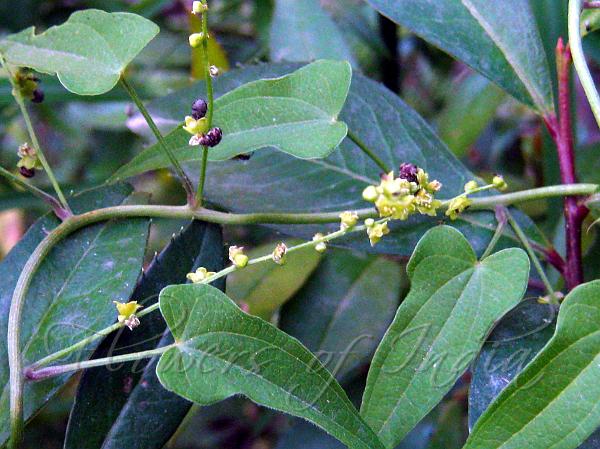|
| Nepal Yam |
|

|

| File size | 692726 |
| Original date | 5/8/12 4:43 PM |
| Resolution | 2048 x 1536 |
| Flash | Flash did not fire, auto |
| Focal length | 6.6mm |
| Exposure time | 1/100s |
| Aperture | 3.0 |
| Focus Distance | |
| Metering Mode | Center weighted average |
| Camera make | Canon |
| Camera model | Canon PowerShot A495 |
| Sensor type | OneChipColorArea |
|
|
|
|
Photo: |
Botanical name: Dioscorea deltoidea Family: Dioscoreaceae (Yam family)
Synonyms: Tamus nepalensis, Dioscorea nepalensis
Synonyms: Tamus nepalensis, Dioscorea nepalensis
Nepal Yam is a hairless vine, twining clockwise.
Tubers are ligneous, irregular. Alternately arranged leaves are simple,
5-11.5 cm long, 4-10.5 cm broad, ovate or triangular-ovate, often
heart-shaped, the basal lobes rounded or sometimes dilated outwards,
7-9-nerved, long-pointed, hairless above, velvety on the nerves
beneath. Leaf-stalks are 5-10 cm long, slender. Male flower spikes
occur solitary in leaf axils, simple or sometimes branched, slender,
lax, 7.5-25 cm long. Flowers are in small distant clusters; stamens 6,
antheriferous. Female spikes are solitary, slender, up to 15 cm long,
few-flowered. Capsule is 2 cm long, 3 cm broad, obovate or obcordate.
Seeds are winged unequally all round. Nepal Yam is found in the
Himalayas, from Kashmir to Assam, Indo-China and W. China, at altitudes
of 450-3100 m. Flowering: May-July.
Medicinal uses:  The juice of the root tuber istaken in the evening in the treatment of
roundworm. It is also used to alleviate constipation. The roots of
most, if not all, members of this genus, contains diosgenin. This is
widely used in modern medicine in order to manufacture progesterone and
other steroid drugs. These are used as contraceptives and in the
treatment of various disorders of the genitary organs as well as in a
host of other diseases such as asthma and arthritis. The roots of this
species contain an average of 4.8% diosgenin.
The juice of the root tuber istaken in the evening in the treatment of
roundworm. It is also used to alleviate constipation. The roots of
most, if not all, members of this genus, contains diosgenin. This is
widely used in modern medicine in order to manufacture progesterone and
other steroid drugs. These are used as contraceptives and in the
treatment of various disorders of the genitary organs as well as in a
host of other diseases such as asthma and arthritis. The roots of this
species contain an average of 4.8% diosgenin.
 The juice of the root tuber istaken in the evening in the treatment of
roundworm. It is also used to alleviate constipation. The roots of
most, if not all, members of this genus, contains diosgenin. This is
widely used in modern medicine in order to manufacture progesterone and
other steroid drugs. These are used as contraceptives and in the
treatment of various disorders of the genitary organs as well as in a
host of other diseases such as asthma and arthritis. The roots of this
species contain an average of 4.8% diosgenin.
The juice of the root tuber istaken in the evening in the treatment of
roundworm. It is also used to alleviate constipation. The roots of
most, if not all, members of this genus, contains diosgenin. This is
widely used in modern medicine in order to manufacture progesterone and
other steroid drugs. These are used as contraceptives and in the
treatment of various disorders of the genitary organs as well as in a
host of other diseases such as asthma and arthritis. The roots of this
species contain an average of 4.8% diosgenin. | Identification credit: Krishan Lal, Gurcharan Singh | Photographed in Sirmaur distt., Himachal Pradesh & Dachigam National Park, Kashmir. |
• Is this flower misidentified? If yes,